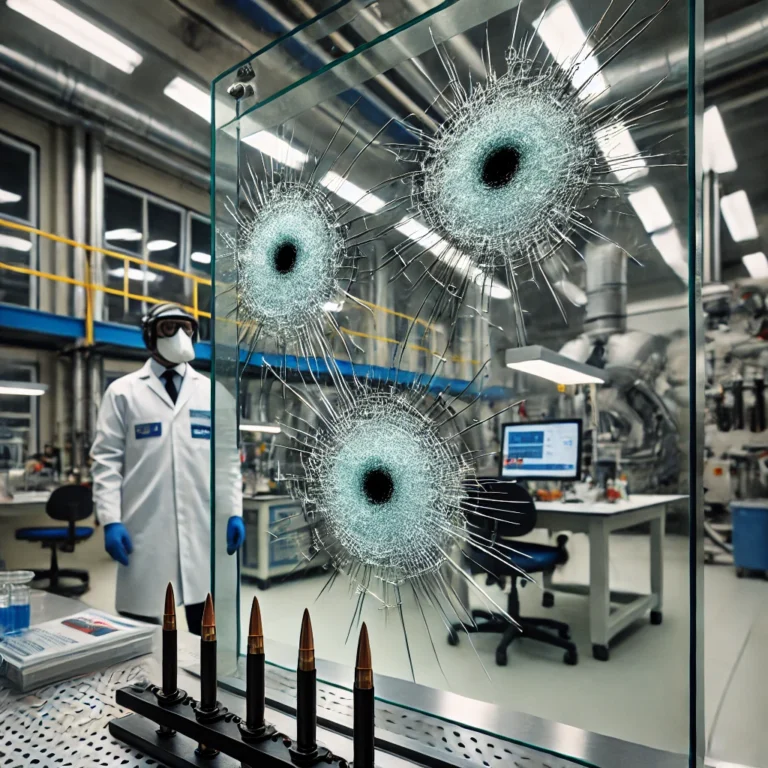Bullet Resistant Glass

Thickness
Thickness: Varies based on protection level, usually ranging from 20 mm to 75 mm (0.78 to 3 inches).
Protection Levels (Standards-Based)
BRG is categorized based on its ability to withstand different types of firearms and bullets, as defined by international standards:
a. UL 752 (Underwriters Laboratories) Standards
- Level 1: Protection against small arms like 9mm handguns and .38 Special rounds.
- Level 2: Protection against higher-velocity handguns like .357 Magnum.
- Level 3: Protection against high-power handguns like .44 Magnum.
- Level 4: Protection against rifles like .30-06 armor-piercing rounds.
- Levels 5 to 8: Protection against multiple higher-caliber and armor-piercing rifle rounds.
- Levels 9 & 10: Protect against military-grade rifles like 7.62mm NATO.
Here’s the Weapons, Ammunition, and Performance Specifications:
| Rating | Weapon | Ammunition | Weight (grains) | Weight (grams) | Minimum FPS | Maximum FPS | No. of Shots |
|---|---|---|---|---|---|---|---|
| Level 1 | Beretta 92 Compact | 9mm Full Metal Copper Jacket with Lead Core | 124 | 8.0 | 1175 | 1293 | 3 |
| Level 2 | S&W Model 686 | .357 Magnum Jacketed Lead Soft Point | 158 | 10.2 | 1250 | 1375 | 3 |
| Level 3 | Colt Anaconda | .44 Magnum Lead Semi-Wadcutter Gas Checked | 240 | 15.6 | 1350 | 1485 | 3 |
| Level 4 | Ruger American | .30 Caliber Rifle Lead Core Soft Point (.30-06 caliber) | 180 | 11.7 | 2540 | 2794 | 1 |
| Level 5 | Springfield Armory M14 | 7.62mm Rifle Lead Core, Full Metal Copper Jacket Military Ball (.308 caliber) | 150 | 9.7 | 2750 | 3025 | 1 |
| Level 6 | Uzi Submachine Gun | 9mm Full Metal Copper Jacket with Lead Core | 124 | 8.0 | 1400 | 1540 | 5 |
| Level 7 | Colt AR15 | 5.56mm Rifle Full Metal Copper Jacket with Lead Core | 55 | 3.56 | 3080 | 3383 | 5 |
| Level 8 | Springfield Armory M14 | 7.62mm Rifle Lead Core, Full Metal Copper Jacket Military Ball (.308 caliber) | 150 | 9.7 | 2750 | 3025 | 5 |
| Level 9 | M1 Garand | .30 Caliber .30-06 Armor Piercing Full Metal Copper Jacket | 166 | 10.8 | 2715 | 2987 | 1 |
| Level 10 | Barrett 82A1 | .50 Caliber Rifle Lead Core Full Metal Copper Jacket, Military Ball (M2) | 709.5 | 45.9 | 2810 | 3091 | 1 |
| Shotgun | Benelli M2 | 12-Gauge Rifled Lead Slug / 12-Gauge 00 Buckshot (12 pellets) | 1.0 oz. / 1.5 oz. | 28.3 / 42.0 | 1585 / 1200 | 1744 / 1320 | 3 |
b. EN 1063 (European Ballistic Standard)
- BR1 to BR7: Based on ballistic threats from handguns and rifles, where BR1 is for small caliber handguns, and BR7 is for high-caliber rifles.
Class Weapon Caliber Type Weight (g) Range (m) Velocity (m/s) Impact Energy Shots BR1 Handgun/Rifle .22 LR LB/RN 2,6 ± 0,1 10,00 ± 0,5 360 ± 10 170 J 3 BR2 Handgun 9×19mm Parabellum FJ/RN/SC 8,0 ± 0,1 5,00 ± 0,5 400 ± 10 640 J 3 BR3 Handgun .357 Magnum FJ/CB/SC 10,2 ± 0,1 5,00 ± 0,5 430 ± 10 940 J 3 BR4 Handgun .44 Magnum FJ/FN/SC 15,6 ± 0,1 5,00 ± 0,5 440 ± 10 1510 J 3 BR5 Rifle 5.56×45mm NATO FJ/PB/SCP 4,0 ± 0,1 10,00 ± 0,5 950 ± 10 1800 J 3 BR6 Rifle 7.62×51mm NATO FJ/PB/SC 9,5 ± 0,1 10,00 ± 0,5 830 ± 10 3270 J 3 BR7 Rifle 7.62×51mm NATO FJ/PB/HC 9,8 ± 0,1 10,00 ± 0,5 820 ± 10 3290 J 3 LB – Lead Bullet
FJ – Full Metal Jacket
FN – Flat Nose
RN – Round Nose
CB – Cone Bullet
PB – Pointed Bullet
SC – Soft Core (lead)
SCP – Soft Core (lead) & Steel Penetrator
HC – Hard core, steel hardness > 63 HRC - SG1 and SG2: Protection against shotguns.
c. NIJ (National Institute of Justice) Standard 0108.01
- Level I, IIA, II, IIIA: Protection from handguns of different calibers.
- Level III and IV: Protection from high-powered rifles and armor-piercing rounds.
| Armor Type | Test Ammunition | Required Hits Per Specimen |
|---|---|---|
| I | LRHV Lead .38 Special RN Lead | 5 |
| II-A | .357 Magnum JSP | 5 |
| II-A | 9mm FMJ | 5 |
| II | .357 Magnum JSP (higher velocity round) | 5 |
| II | 9mm FMJ (higher velocity round) | 5 |
| III-A | .44 Magnum, Lead SWC Gas Checked | 5 |
| III-A | 9mm FMJ | 5 |
| III | 7.62mm, .308 Winchester FMJ | 5 |
| IV | .30-06 AP | 1 |
Key Abbreviations:
- AP: Armor Piercing
- LRHV: Long Rifle High Velocity
- FMJ: Full Metal Jacket
- RN: Round Nose
- JSP: Jacketed Soft Point
- SWC: Semi-Wadcutter
Types of BRG
Different types of BRG are made from various materials and combinations of materials to achieve specific protection levels:
a. Acrylic Glass
- A lightweight, single-layer solution.
- Effective against small arms like handguns.
- Used in low-threat environments (banks, kiosks).
b. Polycarbonate Glass
- Multi-layered composite with polycarbonate sandwiched between layers of glass.
- Higher impact resistance than acrylic.
- Common for moderate threat protection (retail stores, government offices).
c. Glass-Clad Polycarbonate
- Layers of laminated glass and polycarbonate.
- Provides superior ballistic protection while maintaining transparency.
- Used in high-security applications (military facilities, armored vehicles).
d. Laminated Glass
- Multiple layers of glass bonded with a thermoplastic interlayer (often PVB or SGP).
- Provides resistance to bullets as well as forced entry.
- Often used in combination with polycarbonate for higher protection levels.
Application wise BRG
BRG can be classified based on where it is used and the specific security needs of the application:
a. Architectural BRG
- Used in buildings for security purposes.
- Includes installations in government buildings, banks, retail stores, schools, and airports.
- Usually designed to be both bullet-resistant and aesthetically integrated into the structure.
b. Vehicle BRG
- Installed in armored vehicles, including military, government, and VIP vehicles.
- Lightweight versions of BRG designed for mobility.
- Often includes spall protection to prevent the release of glass fragments inside the vehicle.
c. Residential BRG
- Used in private homes and properties where enhanced security is required.
- Often lower levels of protection (handguns, small arms) compared to government and military applications.
d. Specialty BRG
- Fire-Resistant Bulletproof Glass: Combines bullet resistance with fireproof properties.
- Explosion-Resistant Glass: Provides protection from both ballistic threats and explosive impacts.
- Soundproof Bulletproof Glass: Designed for sound insulation alongside bullet resistance, often used in secure meeting rooms or embassies.
Special Types of BRG
BRG can also be differentiated by additional functional features or enhancements:
a. Spall Protection
- Prevents glass fragments from spalling or detaching inside the building or vehicle when impacted by bullets.
- Essential in high-security applications like military vehicles and government facilities.
b. Curved Bulletproof Glass
- Used for aesthetic and functional purposes in vehicles and buildings.
- Allows for unique architectural designs while maintaining ballistic protection.
c. Switchable BRG
- Glass that can switch from transparent to opaque while maintaining bulletproof properties.
- Used in places requiring privacy as well as security, such as conference rooms or luxury vehicles.
d. Insulated Bulletproof Glass
- Combines the insulating properties of regular double-glazed glass with ballistic resistance.
- Used in cold climates where temperature control is important alongside security, such as embassies and high-security residences.


